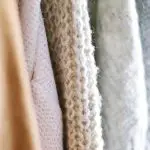Did you know that over 80% of people have had to deal with the frustration of slime on their blankets? If you're one of them, don't worry – we've got you covered with 5 easy and effective methods to remove slime from your cozy blanket.
Whether it's using the freezing method to harden the slime for easy removal or creating a vinegar solution to break down the sticky mess, these techniques will have your blanket looking good as new.
With simple ingredients like baking soda and rubbing alcohol, you can tackle the toughest slime stains without a hassle. Say goodbye to slime and hello to a clean, slime-free blanket in no time!
Key Takeaways
- The freezing method involves placing the affected area in the freezer for 30 minutes, scraping off the hardened slime, and blotting the area with a damp cloth.
- A vinegar solution can be used by mixing equal parts white vinegar and water, spraying it onto the affected areas, dabbing the slime with a cloth, and laundering the blanket as usual.
- Baking soda paste is an option where baking soda is mixed with water to form a paste, which is then applied to the affected area, worked into the slime residue, and wiped away with a damp cloth.
- Rubbing alcohol can be used on suitable fabrics by dampening a cloth with rubbing alcohol, dabbing it onto the slime, allowing the alcohol to penetrate, and gently blotting the area to lift the dissolved slime.
Freezing Method
To remove slime from your blanket using the freezing method, place the affected area in the freezer for approximately 30 minutes. Once the slime has been frozen, use a butter knife or a spoon to gently scrape off the hardened slime from the blanket. Be careful not to damage the fabric while doing this. After removing the slime, you can use a damp cloth with mild detergent to blot the area and ensure that any residue is removed.
This is a great technique for protecting your blanket and preventing slime from causing any long-term damage. The freezing method is an effective way to handle slime without the need for harsh chemicals. This method is particularly useful for preserving the integrity of your blanket, as it doesn't involve any vigorous scrubbing or the use of strong cleaning agents.
Vinegar Solution
One effective way to continue removing slime from your blanket is by using a vinegar solution to break down and lift the remaining residue. Vinegar is a natural cleaning alternative that's both effective and safe for most blanket materials. Here's how you can use a vinegar solution to tackle the slime on your blanket:
- Create the Solution: Mix equal parts of white vinegar and water in a spray bottle. The acidity of the vinegar helps to break down the slime, making it easier to remove. Vinegar also has antibacterial properties, which can help eliminate any lingering odors on the blanket. The diluted solution is gentle on most fabrics, reducing the risk of damage to your blanket.
- Spray and Dab: Liberally spray the vinegar solution onto the affected areas of the blanket, allowing it to sit for a few minutes before gently dabbing the slime with a clean cloth. Avoid rubbing, as this can push the slime further into the fabric.
- Wash and Dry: Once the slime is removed, launder the blanket as usual, and allow it to air-dry. The vinegar scent will dissipate during the drying process, leaving your blanket fresh and slime-free.
Using a vinegar solution provides multiple benefits for effectively cleaning slime from your blanket, ensuring a thorough and safe cleaning process.
Baking Soda Paste
Creating a baking soda paste is another effective method for removing slime from your blanket. Mixing baking soda with water forms a paste that can help in breaking down and lifting any remaining residue, providing an additional cleaning option.
Baking soda offers numerous benefits when it comes to cleaning, making it a versatile and powerful tool for tackling slime stains. Its mild abrasive properties make it excellent for gently scrubbing away residue without damaging the fabric of your blanket. Additionally, baking soda is known for its natural deodorizing properties, which can help eliminate any lingering odors from the slime.
To create a baking soda paste, mix enough baking soda with water to form a spreadable consistency. Apply the paste directly to the affected area of the blanket and gently work it into the slime residue. Allow the paste to sit for a few minutes to penetrate the stain.
Afterward, use a damp cloth to wipe away the paste, along with the dissolved slime. This cleaning tip can be particularly handy for blankets with delicate fabrics or those that require a gentler approach.
Rubbing Alcohol
An effective method for removing slime from your blanket involves using rubbing alcohol to dissolve and lift the residue. Rubbing alcohol is a powerful solvent that can break down the slime, making it easier to remove from the fabric. Here's how to use rubbing alcohol to tackle the slime on your blanket:
- Assess the Area: Check the affected area and ensure it's suitable for treatment with rubbing alcohol. If the fabric is delicate or has special cleaning instructions, consider consulting a professional.
- Apply Rubbing Alcohol: Dampen a clean cloth with rubbing alcohol and dab it onto the slime. Allow the alcohol to sit for a few minutes to penetrate the slime.
- Blot and Rinse: Gently blot the area with a clean cloth to lift the dissolved slime. Then, rinse the spot with water and allow it to air dry.
Using rubbing alcohol is one of the many DIY solutions for tackling slime on your blanket. It's a handy cleaning tip to have in your arsenal for dealing with stubborn stains.
Commercial Stain Remover
To tackle remaining slime residue on your blanket, consider using a commercial stain remover to further lift and eliminate the stubborn stains. Commercial stain removers are specially formulated to break down tough stains, including slime, and are readily available in most grocery or hardware stores. When choosing a commercial stain remover, look for one that is safe for the fabric of your blanket and specifically targets slime or similar stains. Before applying the stain remover, it's essential to check the care label on your blanket to ensure compatibility with the product.
| Pros | Cons | Tips |
|---|---|---|
| Effective | Chemical odor | Test on a small area first |
| Convenient | Costly | Follow manufacturer's guidelines |
| Quick results | Harsh on some fabrics | Air out the blanket after use |
While commercial stain removers are effective, some individuals prefer natural alternatives or DIY solutions. However, if you opt for a commercial stain remover, follow the instructions carefully and consider the pros and cons outlined above to ensure successful stain removal from your blanket.
Frequently Asked Questions
Can I Use These Methods on Other Types of Fabric, Like Clothing or Upholstery?
Yes, you can use these methods on other fabric types like clothing or upholstery. The effectiveness may vary, so take precautions. When adapting slime removal methods, consider the fabric's material and follow specific tips for best results.
Will These Methods Work on Dried and Hardened Slime?
To remove dried and hardened slime from car seats, vinegar is effective. Apply it to the affected area and let it sit for a few minutes before wiping it away. This method works well on various fabric types.
Are There Any Safety Concerns or Potential Damage to the Blanket When Using These Methods?
When using these methods, there are potential concerns about damaging the blanket. It's important to consider the fabric type and care instructions to ensure safety. Always test on a small area first.
Can I Combine Any of These Methods for Tougher Slime Stains?
Yes, you can combine methods for tougher slime stains. This can increase the effectiveness of stain removal. Consider using alternative techniques such as pre-treating with vinegar or enzyme-based cleaners before washing.
Are There Any Alternative Methods for Removing Slime From a Blanket That Are Not Mentioned in This Article?
Looking for alternative techniques to remove slime from a blanket? Try DIY solutions like vinegar and baking soda or natural remedies like lemon juice. Unconventional approaches such as using ice cubes can also work.
- How Does Ring Spun Cotton Affect Garment Fit and Shape Retention? - August 13, 2024
- What Are the Challenges in Producing Ring Spun Cotton? - August 13, 2024
- Is Ring Spun Cotton Suitable for Plus-Size Clothing? - August 13, 2024







